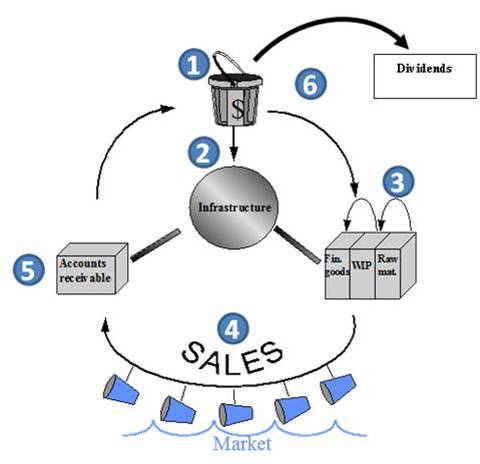 Want to add meaningful and measurable value to your customers? Become a cash flow engineer.
Want to add meaningful and measurable value to your customers? Become a cash flow engineer.
We’ve been told for years that the best way to add long term value to customers is to be consultative or to sell solutions, and I don’t disagree—but it’s no longer enough. The problem is that these terms start becoming vague clichés—and since there is no commonly agreed definition anyone can claim to be a consultative salesperson. The result is that customer and prospects become jaded and easily dismiss any such claims.
Cash flow engineering: it’s a new term and a new approach which is different and concrete. It will allow you to get your buyer’s attention—and deliver on that promise.
Why is cash flow so important to your customers?
A simple yet powerful model for understanding your customer’s business is to see it as a huge engine for generating cash. Cash is the central ingredient of any business operation—it is the enabler and the ultimate objective of all business activity. Every business uses cash to generate more cash.
Although management pundits may disagree, investors know the truth: a company’s principal mission in life is to generate cash for its owners. That’s why visionaries invent and investors invest. Only through generating cash will the company be able to dole out dividends to investors, pay salaries, or grow the business.
In effect, the entire infrastructure of the business, the legions of employees, the business processes, and all that the enterprise comprises is a vast cash generating engine. In order to understand how the business functions, you must be able to trace the cash flows through the engine.
Most importantly, the business decision-makers you sell to pay close attention to it. The key, therefore, to improving the business is to understand how the engine operates, and what it needs to run strong, lean and fast.
Think of yourself as a cash flow engineer for a temperamental race car. Keeping the engine running is important, but you are also constantly searching for ways to squeeze better performance out of it to put the drivers in the best position to win. If you understand how their engine works and suggest concrete improvements that improve the engine, then you are adding real measurable value
Your customer’s cash flow engine
Let’s see how the engine works:

1. Assume that the firm has just been formed. For the moment, its only asset is a great big “bucket” of cash.
2. The only problem with this bucket is that it leaks. Cash is being rapidly sucked out of the bucket by a part of the engine called infrastructure comprising such things as machines, office buildings and equipment, and administrative staff.
3. In order to refill the bucket, you will buy or produce inventory for sale to the market. This is not a trivial process. Yu must acquire raw materials, process it to create finished goods, store it, keep track of it, etc. Every one of the processes takes cash and time, and every dollar that remains in one of these piles is one that is not being cycled through to generate more cash.
4. Next, the inventory must be sold. Unless it is a busy retail operation, this also takes time. As you well know, complex systems sales can have a frustratingly long sales cycle.
5. Once the goods are delivered, the company must still wait for customers to pay. Often, just compiling the information to prepare a proper bill takes time, as does the printing and mailing. Until then all they have to show for their efforts is accounts receivable, which you can’t spend at the grocery store.
6. At last, the cash begins to flow back in to the bucket. Even though you had to leave a lot along the way, in the form of inventory reserves and unpaid receivables, the cash flow engine is beginning to do its job. Cash flows back into the bucket and can then be reinvested into the cycle to generate yet more cash, or to pay dividends. Note that I did not use the word “profit”; profit is not real, it’s only an accounting convention. Cash is real—you either have it or you don’t.
5 ways to engineer more cash flow
Every time the engine turns over, it generates cash. Cash flow improvements come from making the engine more powerful, leaner, or faster. When you look at it this way, you will see that there are five main ways to generate measurable cash flow impact.[1]
More powerful:
- Make the engine bigger: Increase the volume running through it by increasing production or making their products more attractive.
- Increase the size of the buckets: Increase the gross profit margin.
Leaner:
- Reduce the amount taken out: Lower costs.
- Reduce the amount needed to run it: Improve asset efficiency.
Faster:
- Make the engine run faster: Speed up parts or the entire cycle.
Seeing your customer’s business operations this way expands the range of possible improvements beyond saving money and increasing revenues; this allows you to connect with a broader variety of “problem owners” and speak in the terms that they care about. Of course, every engine is different and it takes time and effort to know enough about each one to make a real difference.
Sales pitch for my book
Here’s where I drop the other shoe. This article has had to vastly simplify the idea of the cash flow engine, and of course the devil is in the details. If you want to improve your own cash flow engine, you can learn the details in the new revised and expanded edition of my book, Bottom-Line Selling: The Sales Professional’s Guide to Improving Customer Profits. Or, if you want to try before you buy, you can get a free copy of Chapter 7, which explains the cash flow engine in detail, here.
[1] There are other important benefits you can bring to your customers besides these, of course, but they are much less tangible.
Last week I wrote about how important it is to have a clear structure for your executive sales presentation. This article is about three rules that will make your presentation engaging and convincing.
Tension and resolution
Although a story is a powerful format for a presentation, it does not have to be strictly chronological. The key attribute of story is not chronology, but tension and resolution. In other words, the story creates some tension in our minds—a mismatch between what is happening and what we want to happen; that’s what grabs our interest, and the promise of having that tension resolved is what sustains our interest.
That’s why sales presentations are so well suited for some sort of narrative structure: they are about solving problems for customers. In his classic book, Moving Mountains, Henry Boettinger is worth quoting at length:
It’s amazing how much sales wisdom must be relearned every day.[1]
I’ve just finished reading Confessions of an Advertising Man by David Ogilvy, which is a delightful book that contains lessons in many areas besides advertising. In this article, I want to focus on just one paragraph which even today constantly bears repeating:
“Dr. Gallup is a fountain of useful information on how people react to different kinds of commercials. He tells us that commercials which start by setting up a problem, then wheel up your product to solve the problem, then prove the solution by demonstration, sell four times as many people as commercials which merely preach about the product.”
Let’s deconstruct that second sentence and apply it to sales calls.
- Start by setting up a problem. This is the essence of solution selling, which is too often forgotten. Too many people talk about “solutions” without once referring to problems. Beginning with problems shows the customer you care, and that you took the time to research and understand their situation. “Setting up” a problem also includes getting the customer to articulate the problem themselves, and elaborate on your initial understanding. The next step is to make sure you quantify in some way the cost or impact of the problem to the customer. We all have problems but only finite resources and attention to devote to them, so the itch has to be urgent before someone will scratch it. If you omit this step and jump right to the solution, they won’t appreciate the full value.
- Wheel up your product to solve the problem. In a sixty second commercial, you have to go right into explanation mode, but this only allows you to explain the one benefit. In a sales call, you have the time to get the customer involved in wheeling up your product by having them articulate the benefits. Also, with more complex solutions, one size does not fit all, so to the extent you can tailor your presentation to their unique needs expressed in the problem phase, the better off you are.
- Prove the solution by demonstration. The key mistake often made here is that demonstrations go into too much detail, because the salesperson is in love with everything the product can do. Your job here is only to prove the solution to the customer’s pressing problem. It’s too easy to talk past the close, bore the customer or open up potential objections when you go off into unnecessary tangents.
- Sell four times as many people. I love it when sales practices are backed up by research! How rare is that?
[1] In his book, Ogilvy says “Keep your opening paragraph to a maximum of eleven words.”
I teach a class on “Getting In”, which includes how to write a communication that will grab the attention of a senior level prospect and get them a first appointment. Although I have been teaching it for years, about once a month I will get an email from a former student asking for a copy of the format, so I’ve decided to release it here. At the same time, one of my former students, who is now a senior executive and therefore is the target of these types of letter, occasionally sends me examples of terrible letters he gets, so this is also my modest attempt to raise the reputation of salespeople in general.
Your subject line should be unique to the recipient. There are a number of ways you can do this. You can refer to an issue that is important to their industry or their company. You can use a quote from their CEO or their annual report. If you’re feeling particularly bold, you can even refer to their competition, as in “beating Company X in service quality.”
One caveat: it’s essential that the first paragraph of your email be a natural extension of the subject line, or they will feel like they’ve been victimized by a bait-and-switch tactic.
Lead Off by Referring to the Prospect’s Company, Not Your Own. This will demonstrate your knowledge and expertise and imply a problem-solving approach. Do the research so you can refer to an issue you know the company is facing (either because you know about the company itself or because you are aware of issues faced by other companies in that industry).
“In reading your 2010 10K, I noticed that one of your principal strategies is to improve asset efficiencies by 10% in the next two years.”
The next sentence can amplify the problem or opportunity they face:
“Meanwhile, increasing security requirements are forcing increased investment in…”
You can also find a useful perspective on how to write this first paragraph in this article posted by sales expert Jeff Ogden.
Next, introduce Your Company and Describe How You Solved That Problem for Similar Clients.
“__________________ can help you get maximum efficiency out of your ____ assets and infrastructure by…, as we have done for…”
This section should be brief and focus on results, not products. Leave out your features and resist the temptation to throw in terms such as “industry-leading, cost-effective,” etc.
Tell Them Why They Need to Get Personally Involved. If they are intrigued after reading your first two paragraphs, they may still think it’s OK to pass on your note to a lower level person. Although this is not always a bad thing, you’ll be better positioned for the sale if you can keep them personally invested in the process.
“Although these decisions are normally made by your purchasing department, the technology has advanced to the point where we impact a broad range of company functions, and only someone at your level has a broad enough vision to set the initial direction.”
Request Action. Inform the prospect that you will be calling to arrange a meeting. (Helpful hint: find out the gatekeeper’s name before sending the message, and incorporate it into the message)
“I will call you early next week to arrange a meeting with you or your designated representative to plan for how we might be able to deliver similar results to…
If you will not be available at that time, kindly inform Madeline when would be a convenient time to talk.”
This outline has been very effective in helping my students—and me—get C-Level appointments. It’s important to be brief and to the point, and to keep it as prospect-focused as possible. Resist selling your product and/or benefits; your main purpose is to get that first appointment or discussion.





